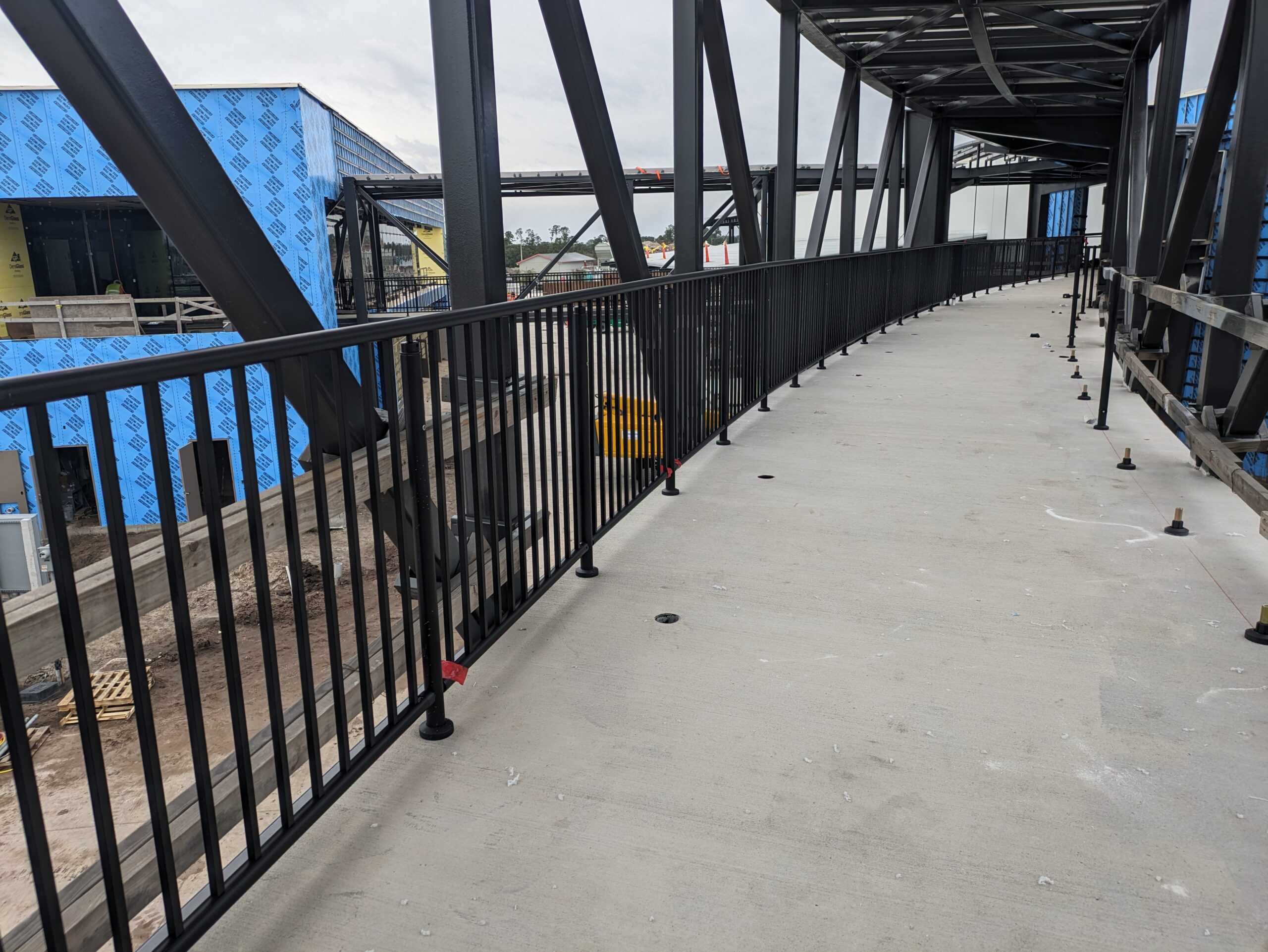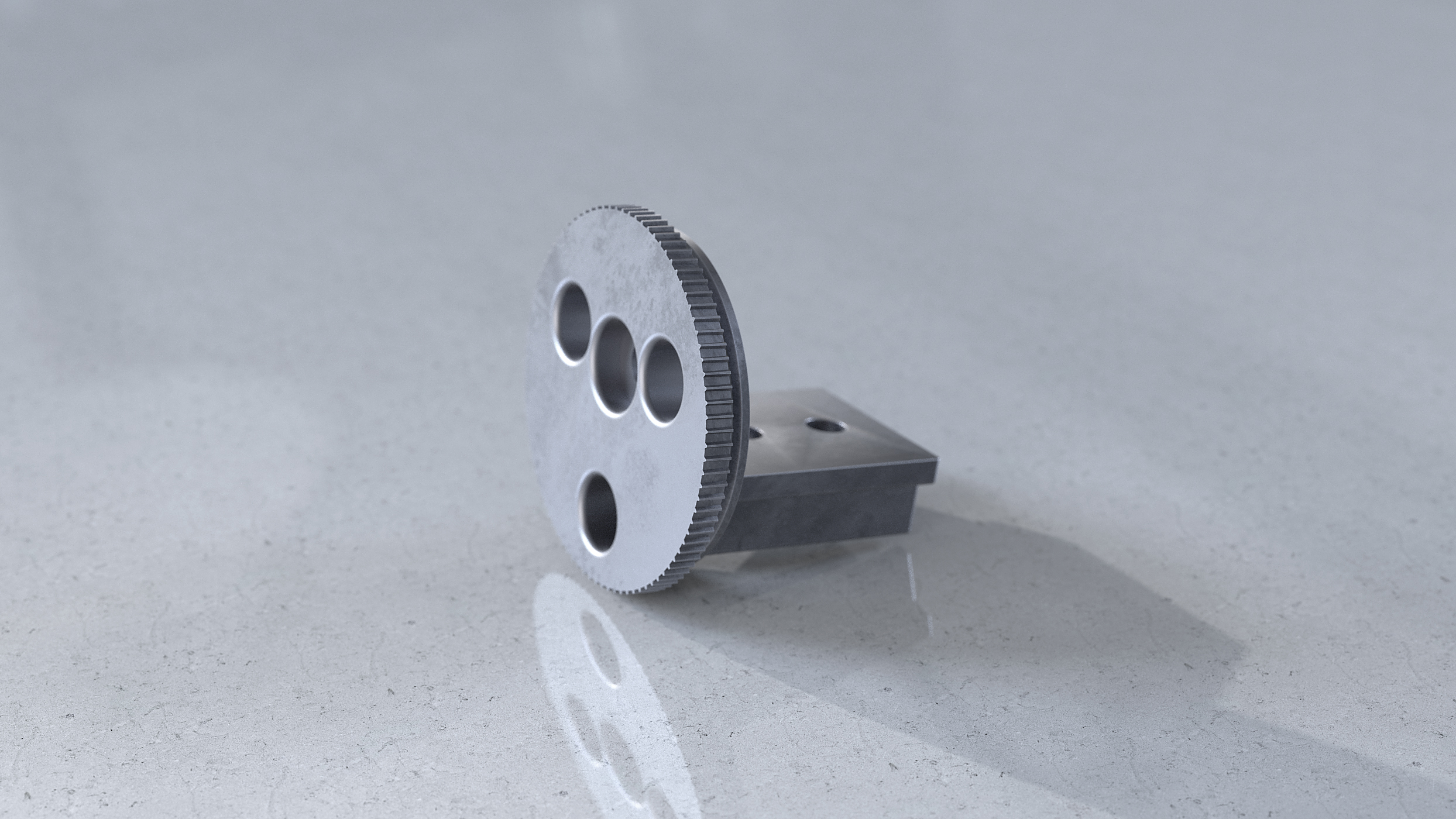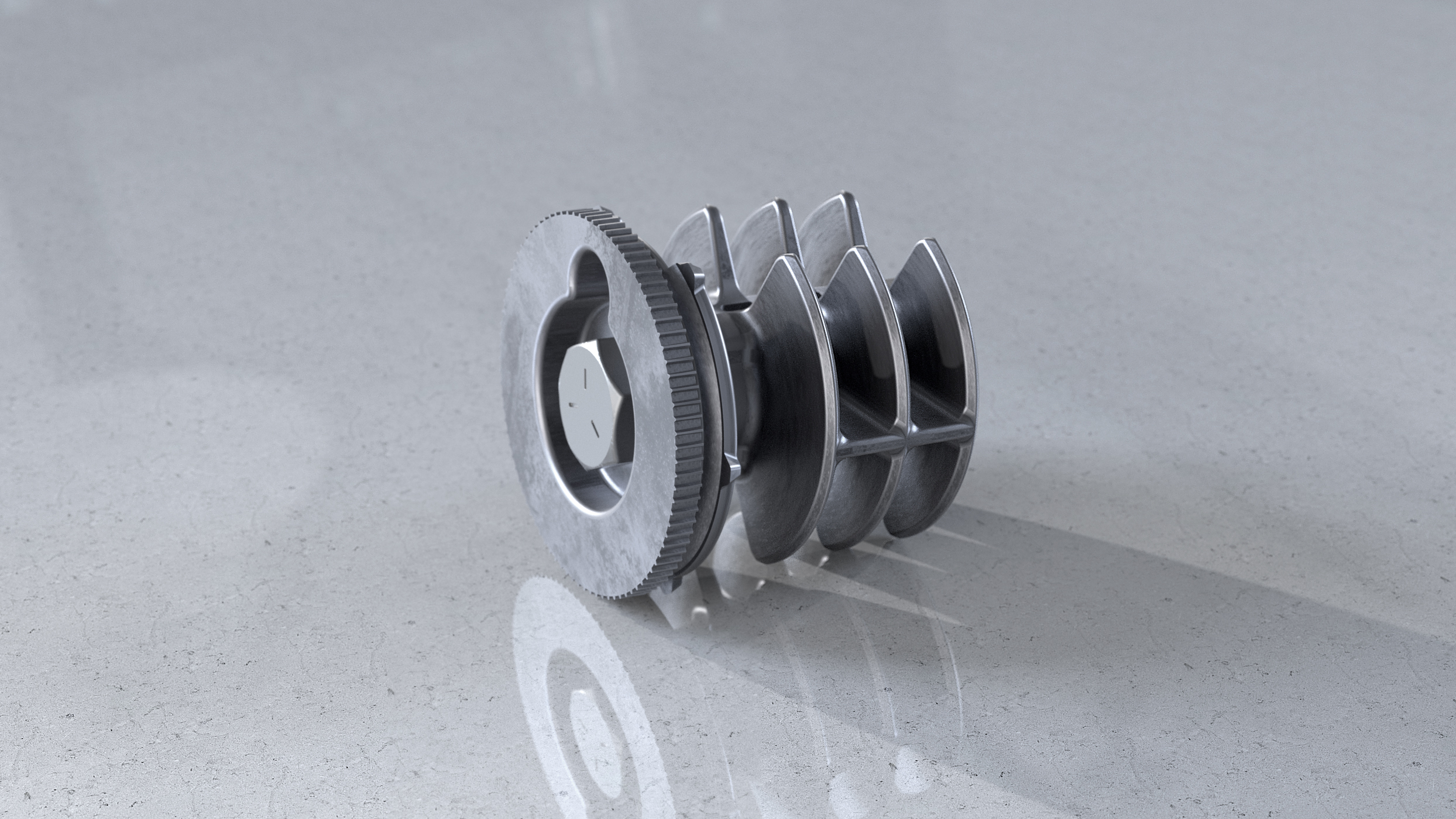Why are Handrails Important?
Each year,1 million Americans are injured as a result of slips, trips, and falls on stairways, according to a study conducted by the American Journal of Emergency Medicine. Handrails provide support and stability while climbing up or down a flight of stairs, walking down a hallway or walkway, or maneuvering in a bathroom. They add a third point of contact, which is essential for older populations and extremely beneficial for the younger population as well.
When used properly handrails can decrease the rate of falls, leading to safer environments. They provide a universal design element that benefits all populations. Ideally, handrails should have a “‘power grip’, which allows the entire hand to grab the rail rather than just the fingers, more severe injuries during a fall.” While most injuries treated in the emergency room and analyzed in this study were minor and included sprains and strains, some people sustained fractures or concussions as a result of their fall, making the inclusion of handrails extremely important in preventing both minor and serious injuries.
What is a Handrail?
A handrail is an extended rail, fixed to posts or walls, that creates support and stability while traveling on a walkway, climbing up or down a stairway, walking in a hallway, or moving in a bathroom.
Handrail vs. Guardrail
In many cases the terms ‘handrail’ and ‘railing’ have come to be used interchangeably. In reality, however, they are very different and it is important to distinguish between the two.
A guardrail, often referred to as a railing, is used to prevent people from falling off of a stairway rather than falling down one. A guardrail can also act as a barrier for a porch, deck or balcony, preventing people from falling off of the edge.
Oftentimes, guardrails on stairs also act as makeshift handrails and incorporate an indentation for a pinch grip where the fingers are doing most of the work. This grip is less stable than a power grip and doesn’t provide the level of safety and fall prevention that a true handrail does. ‘Old-style’ handrails with pinch-grips also don’t meet ADA regulations.
A true handrail is designed with fall prevention in mind, complies with the ADA guidelines, and makes stairways, walkways, hallways, and bathrooms safer, not only for those with mobility issues but for people of all ages and abilities.
Grips
Pinch Grips
A pinch grip occurs when the force of the grip comes from pinching the fingers and thumbs towards each other. A pinch grip only allows for 25% of the maximum grip strength and is ideal for precision maneuvers such as picking up small objects, using a pencil, or eating a sandwich.
 Many decorative wooden railings incorporate a pinch grip, which is effective for guidance up and down the stairs, ramp, or walkway, but does not allow for enough grip strength to prevent a fall. Imagine trying to use a hammer if the handle were shaped like a decorative stair railing! These types of handrails don’t meet ADA regulations.
Many decorative wooden railings incorporate a pinch grip, which is effective for guidance up and down the stairs, ramp, or walkway, but does not allow for enough grip strength to prevent a fall. Imagine trying to use a hammer if the handle were shaped like a decorative stair railing! These types of handrails don’t meet ADA regulations.
Power Grips
A power grip is 5 times stronger than a pinch grip and allows for maximum grip strength as the fingers flex towards the palm. Proper handrail design includes a power grip.
 A cylindrical handrail with a diameter between 1-¼” and 2” provides the maximum grip strength, reducing and preventing falls on stairways and ramps. In addition, a power grip allows those with mobility impairment to use their arm and upper body strength to assist their lower body when climbing or descending.
A cylindrical handrail with a diameter between 1-¼” and 2” provides the maximum grip strength, reducing and preventing falls on stairways and ramps. In addition, a power grip allows those with mobility impairment to use their arm and upper body strength to assist their lower body when climbing or descending.
Functional Handrail vs Decorative Handrail
Diameter
A functional handrail, one that is compliant with ADA regulations, should ideally be circular with a diameter between 1-¼” and 2”. If the profile is non-circular, the maximum cross-section dimension allowed is 2-¼” and the perimeter measurement must be between 4” and 6-¼”.

Decorative or non-functional handrails, which do not comply with the ADA guidelines, are permitted only in private residences. If they have a perimeter greater than 6-¼” they must include a graspable finger recess on both sides, and the minimum width of the handrail above the recess must be between 1-½” and 2-¾”.
Bracket Design
Handrail brackets are available in a wide variety of styles. To comply with regulations, which requires that a hand must be able to pass unobstructed over the entire length of the handrail, they must ensure that the distance between the adjacent wall and the gripping surface of the handrail is a minimum of 1-½” (38mm).
 Brackets that are “L” shaped are the most effective in creating a handrail free from obstruction. They allow for the passage of the fingers as people grip the handrail to guide themselves up and down stairways, hallways, and ramps. An ADA-compliant handrail should have L-shaped brackets, where the horizontal portion that attaches to the wall is at least 1-½” (38mm) below the handrail profile.
Brackets that are “L” shaped are the most effective in creating a handrail free from obstruction. They allow for the passage of the fingers as people grip the handrail to guide themselves up and down stairways, hallways, and ramps. An ADA-compliant handrail should have L-shaped brackets, where the horizontal portion that attaches to the wall is at least 1-½” (38mm) below the handrail profile.
 What are the Handrail Requirements?
What are the Handrail Requirements?
Commercial vs Residential
‘Commercial’ is shorthand for commercial, industrial, institutional, publicly-accessible, or public areas of multi-unit residential structures. Most locations fall into one of these categories.
‘Residential’ refers to one and two-family dwellings, and the private spaces of multi-unit residential structures only.
Common areas of residential buildings with three or more units, or with more than three stories, must conform to the same regulations as commercial locations.
Building Code vs ADA Standards
Building codes come into play during construction or renovation, and also when an insurance or home evaluation inspection is performed. They are adopted and enforced at the state and local level. With some local variations, all jurisdictions follow the International Building Code published by the International Code Council.
ADA regulations apply to all public and commercial locations, and are enforced country-wide by the Justice Department. ADA regulations are applied to existing structures regardless of whether they must comply with the current building code.
Building codes are concerned primarily with safety, whereas the ADA Standards are focused on accessibility. Because handrails are important for both, there is a substantial amount of overlap. Commercial building codes contain virtually all of the ADA handrail standards as well as additional requirements for strength and utility. Residential building codes, while not quite as stringent, contain many of the ADA standards as well.
Handrail Regulations
| Commercial and ADA locations | Residential locations | |
| Handrails must be installed on at least one side of every stairway with two or more steps, and every ramp with a slope greater than 1:20 | X | X |
| Handrails must be installed on both sides of stairways and ramps and, with the exception of ‘monumental’ steps, no part of a stairway or ramp may be more than 30” from a handrail. | X | |
| The top surface of handrails must be 36”, plus or minus 2”, above the surface of the ramp or the stairs, measured from the stair nosings. | X | X |
| Handrails must be uninterrupted for the full length of the ramp or continuous runs of stairs. A stairway that includes “winders”, or pie-shaped steps, is considered a continuous stairway, therefore the handrail must turn with the stairs. | X | X |
| The space between the handrail and adjacent surface (such as a wall), must be at least 1 ½”. | X | X |
| The ends or extensions of handrails must return to a wall, guard, or landing surface. | X | X |
| Ramps: handrails must extend horizontally for 12” minimum beyond the top and bottom of the ramp runs. | X | |
| Stairs: Handrails must extend horizontally above the landing for 12” minimum, beginning directly above top riser nosing. Handrails must extend, at the same angle as the stairs, beyond the nosing of the bottom step by one tread depth. | X |
Residential Stairway with Landing
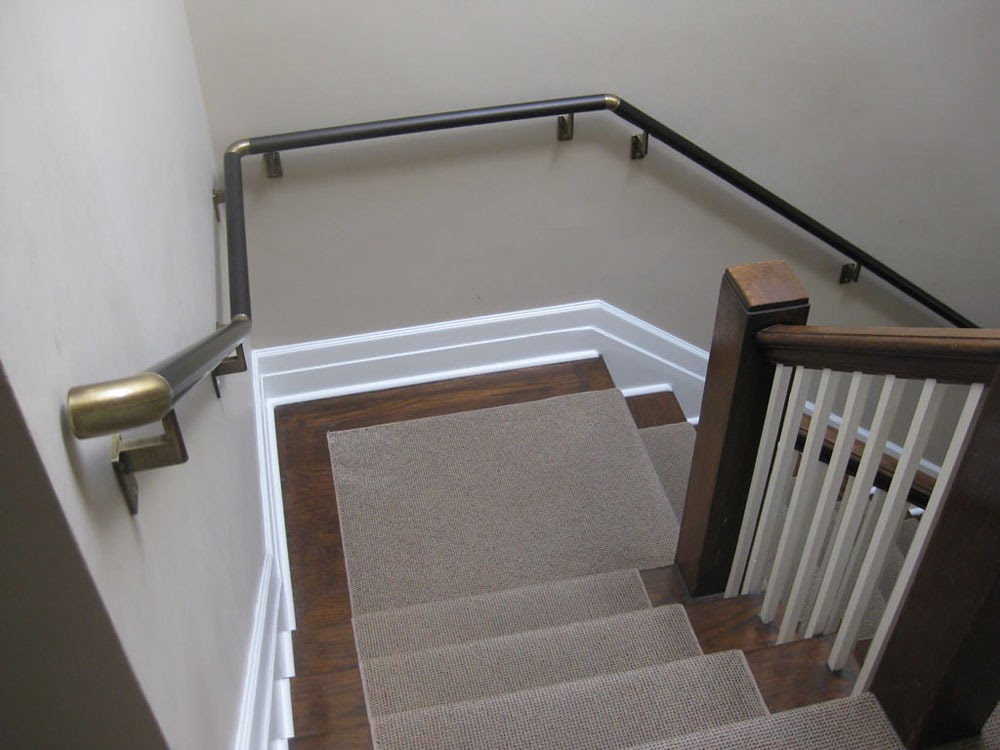 Handrails on the outer perimeter of a landing are not technically required by code but are considered part of “best practices” for stairway safety and falls-prevention.
Handrails on the outer perimeter of a landing are not technically required by code but are considered part of “best practices” for stairway safety and falls-prevention.
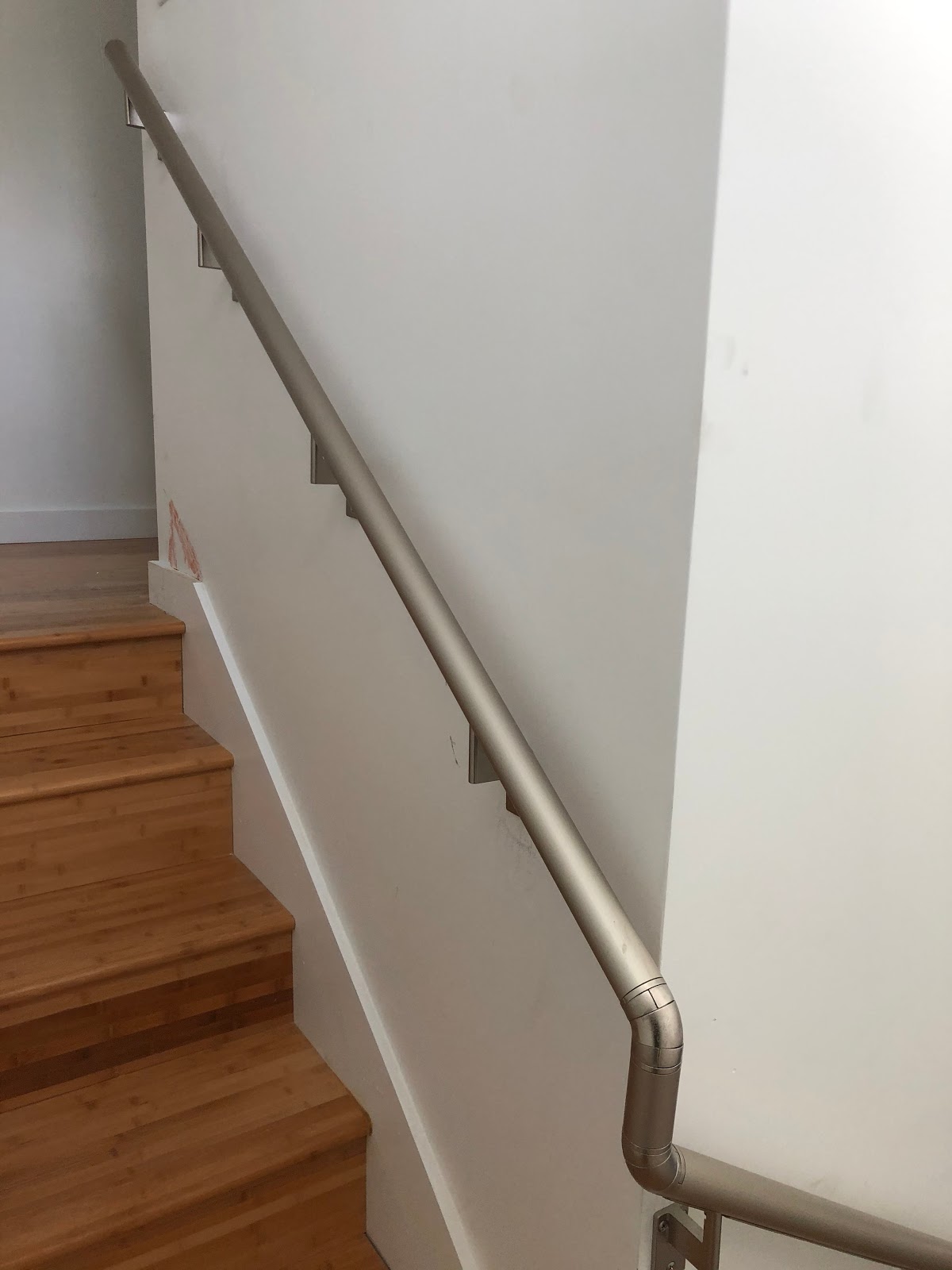 “Winders”. Pie-shaped steps. Always considered continuous.
“Winders”. Pie-shaped steps. Always considered continuous.
ADA ramps with a rise of 6” and on walking surfaces with running slopes greater than 1:20 also require handrails to comply with ADA regulations. If they are provided on walking surfaces with running slopes less than 1:20, they are required to adhere to ADA standards.
How to Choose a Handrail Material
The ideal handrail material depends on the application, location, and aesthetic of the desired handrail.
For commercial applications where handrails will receive a lot of use, choosing a material that is highly durable, unlikely to rust, and easily cleaned is ideal. In residential applications, especially private homes, handrails won’t receive as much use, so a less durable material may be acceptable, especially if taking design into account.
If the handrail is to be located outdoors, durability is essential to getting the most out of a handrail. Choosing a material that can stand up to sun, wind, rain, and snow will ensure that the handrail will last and continue to look great.
Materials
Wood
Wood is a strong and durable material for a handrail. It also has a timeless look and can be integrated into a variety of design styles. It does, however, require maintenance over time as it wears and possibly splits or splinters. Many products require sanding and coating before use, and frequent refinishing is required if wood handrails are used outdoors or in wet environments.
A wood handrail also has a difficult time complying with continuous handrail requirements if the stairway includes non-standard angles, winding stairs, or a joggle that would require a bend. Longer length handrails are prone to warping and wall returns are difficult to accomplish with this material.
Often, wood is used for a decorative handrail, the profile of which has a pinch grip rather than a power grip, making a decorative wood handrail less safe than one with the r round power grip profile.
Wrought Iron
Wrought iron handrails add aesthetic appeal while also adding the safety of a handrail. The material is flexible which makes it forgiving in the event that the stairway heaves or flexes. Unfortunately, wrought iron is susceptible to rust, a susceptibility exacerbated by the rough finish that allows rust to form in the small pits on the surface. For an ADA compliant handrail, wrought iron is not ideal as its profile is too small to create an optimal handrail grip. Because of the weight of the material, an ADA compliant profile would be too heavy.
Stainless Steel
Stainless steel is long-lasting, durable and easy to clean. As a handrail material, however, it comes with a high price tag, especially if non-standard angles are required. Aesthetically, it creates a modern industrial appearance that, while very attractive, doesn’t compliment all decor styles.
Aluminum
Aluminum handrails aren’t susceptible to rust or corrosion, making them a durable, long-lasting choice. The material works well in commercial applications where they will receive a substantial amount of use as they stand up well to high traffic over time. Depending on the design aesthetic and finish, aluminum can also be integrated into a residential design. Another benefit is that it is easily cleaned and disinfected with a simple wipe down.
Choose a Sturdy, Attractive Handrail
 Whether used for a residential or commercial application, on a staircase or in a hallway, in a retirement home or elementary school, handrails create support and stability for anyone traveling from one place to another.
Whether used for a residential or commercial application, on a staircase or in a hallway, in a retirement home or elementary school, handrails create support and stability for anyone traveling from one place to another.
They are an integral part of helping a loved one age in place, provide support on a slippery walkway, and create a safe way to climb stairs, yet we may not realize how much handrails affect us in our daily lives. That’s the beauty of great design; it becomes part of the decor yet we use it without even realizing how much we depend on it.
Installing a handrail on a staircase, in a hallway or bathroom, or on a ramp provides the support necessary to navigate slippery conditions and slopes while looking beautiful and allowing us to move safely throughout the day.







